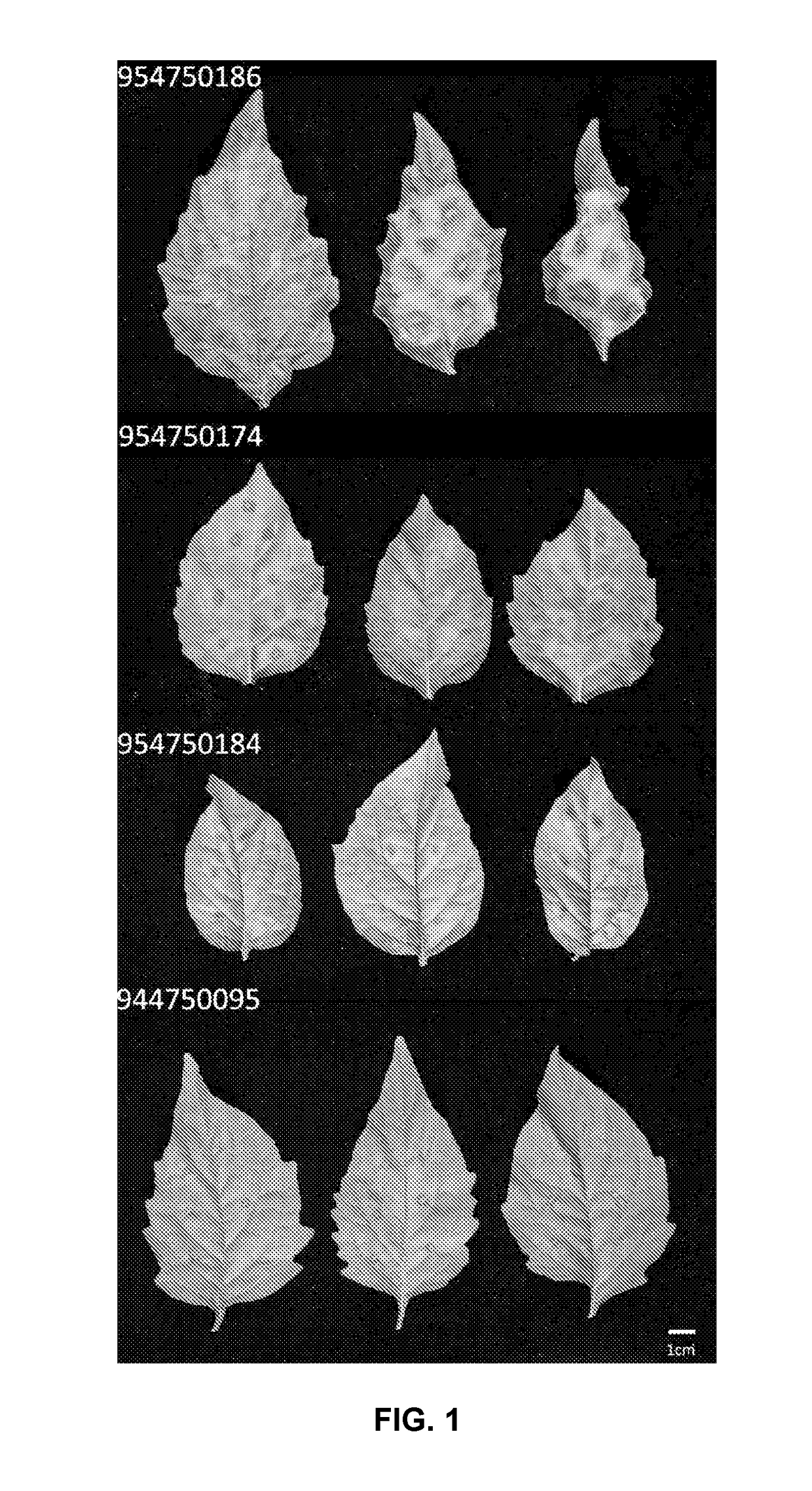Late blight resistance gene from solanum americanum and methods of use
a technology of resistance gene and solanum americanum, which is applied in the field of gene isolation and plant improvement, can solve the problems of rpi gene that is overcome, laborious and slow process, and laborious time-consuming classical map-based cloning, and achieve the effect of limiting plant diseases
- Summary
- Abstract
- Description
- Claims
- Application Information
AI Technical Summary
Benefits of technology
Problems solved by technology
Method used
Image
Examples
example 1
Solanum americanum is a Rich Source of Late Blight Resistance Genes
[0183]We set out to investigate the immune response towards P. infestans in a set of S. americanum (2n) and S. nigrum (6n) accessions obtained from three European seed collections (Table 1). Flow cytometry analyses identified that accessions 944750095, A54750014 and A14750006, originally listed as S. nigrum, were diploid, rather than hexaploid (data not shown). This is in accordance with previously reported frequent misidentification between S. nigrum and S. americanum (Manoko et al. (2007) Plant Syst. Evol. 267:1-11). For the purposes of the present invention, all plant accessions will be referred as belonging to S. americanum sensu latu group, unless stated otherwise or apparent from the context of usage. Furthermore it is recognized the present invention does not depend on the R genes of the present invention being isolated from a particular plant species or even that the species is in the genus Solanum. Moreover,...
example 2
RenSeq Mapping Reveals that Rpi-amr3 Maps Near R2 on Potato Chromosome 4
[0186]Pathogen inoculations on leaves of young F2 plants (F1 954750186×944750095) revealed 99 resistant and 6 susceptible plants (15:1 segregation), suggesting the presence of two unlinked dominant Rpi genes. To separate the genes, we self-pollinated 15 resistant F2 plants and determined the resistance segregation pattern in 30-200 F3 progeny. Four populations segregated 3:1 in DLA tests on leaves from young plants (8-10 weeks old). Interestingly, this result was not consistent in older plants, suggesting the presence of an additional resistance gene functional in adult plants (more than 12 weeks old) that were scored as susceptible when young.
[0187]We hypothesized that the underlying late blight resistance genes encode NB-LRR / NLR proteins. We applied RenSeq to resistant (R) and susceptible (S) parents, and to bulked DNA of the 50 most susceptible plants, including the 6 originally identified susceptible F2s, an...
example 3
RenSeq Combined with PacBio Sequencing Enables Assembly of Full-Length Sequences for 14 Co-Segregating Full-Length NLR Genes
[0190]A major driver for this project was to establish an R gene cloning method that does not require construction of BAC libraries. We previously found that the high copy numbers and sequence similarity of NLR genes complicates de novo assembly of short Illumina RenSeq reads (Jupe et al. (2013) Plant J. 76:530-544; Andolfo et al. (2014) BMC Plant Biol. 14:120). We therefore explored NLR enrichment in combination with longer read technology offered by the PacBio RSII (Eid et al. (2008) Science 323:133-138). We used our Solanum NLR bait library (Jupe et al. (2013) Plant J. 76:530-544) to capture the full NLR complement from two independent libraries (1.5 kb and 2.5 kb gDNA fragments) derived from the Rpi-amr3-carrying parental accession 944750095 (see Methods for details). Sequencing 1.5 kb and 2.5 kb fractions on one and two SMRT cells, respectively, resulted i...
PUM
| Property | Measurement | Unit |
|---|---|---|
| resistance | aaaaa | aaaaa |
| nucleic acid | aaaaa | aaaaa |
| size | aaaaa | aaaaa |
Abstract
Description
Claims
Application Information
 Login to View More
Login to View More - R&D
- Intellectual Property
- Life Sciences
- Materials
- Tech Scout
- Unparalleled Data Quality
- Higher Quality Content
- 60% Fewer Hallucinations
Browse by: Latest US Patents, China's latest patents, Technical Efficacy Thesaurus, Application Domain, Technology Topic, Popular Technical Reports.
© 2025 PatSnap. All rights reserved.Legal|Privacy policy|Modern Slavery Act Transparency Statement|Sitemap|About US| Contact US: help@patsnap.com



